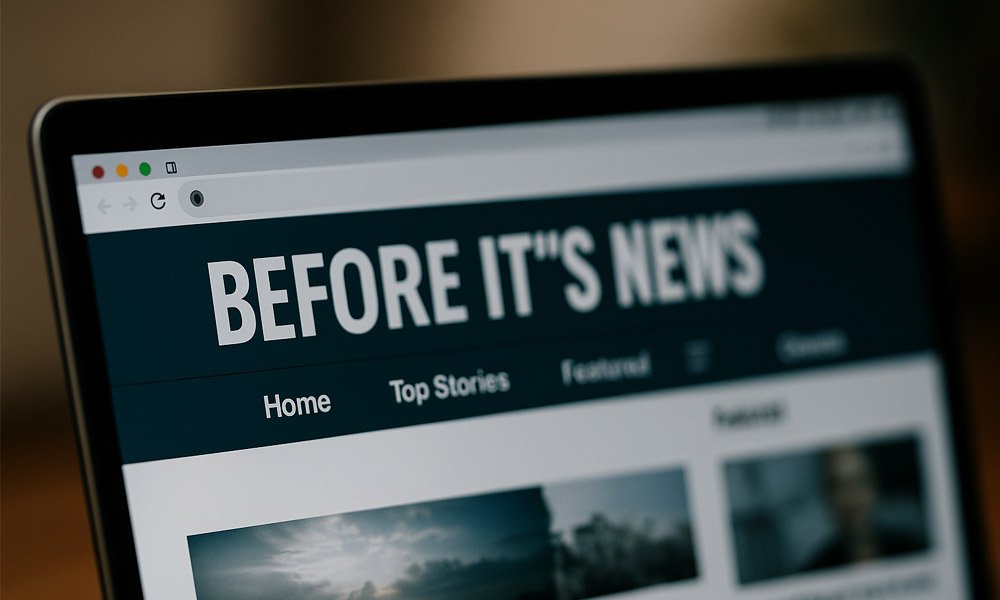Guide
Is Before It’s News Telling the Truth? Here’s What You Should Know
Published
4 months agoon
By
Archie
Have you ever come across a headline online that made you stop and say, “Wait, what?!”
Maybe it said something wild like, “Aliens Built the Pyramids” or “The Government Is Hiding the Truth About Time Travel.” Chances are, that story came from a website called Before It’s News.
In this article, we’re going to take a close and easy look at what Before It’s News really is. We’ll talk about where it came from, how it works, what kind of stories it shares, and most importantly, can you trust it?
Let’s break everything down in a simple way so you can understand the full picture.
What Is Before It’s News?
Before It’s News is a website that lets anyone post news, ideas, or personal stories — even if they’re strange, shocking, or not true.
It started back in 2009. The idea was to give people a place to share news that’s not controlled by big news companies or governments. On this site, you don’t have to be a reporter or a scientist. You can just write and post.
It’s like a giant public notice board where people around the world can share what they believe or think is happening, no matter how unusual it sounds.
Who Created It and Why?
The site was created by Chris Kitze, a tech entrepreneur. He said he wanted a space where people could speak freely — even if their stories weren’t welcome on regular news channels.
Chris believed that mainstream news often hides the full truth or only shares one side of the story. So, he built Before It’s News as a place where people could publish the “other side.”
It’s a bold idea. But it also comes with a big problem: anyone can post anything, even if it’s not true or safe.
How Does the Website Work?
Before It’s News works in a very simple way. You just:
-
Make a free account.
-
Pick a topic or category.
-
Write your article.
-
Hit publish, and your story goes live.
That’s it. There are no editors, no fact-checkers, and no one double-checking the information.
This means you’ll find everything from personal experiences and opinions to full-blown conspiracy theories on the site. Some stories might be based on real facts, but many are not.
Readers can leave comments, and there’s also a system where users can vote on articles they like. But just because something has a lot of votes doesn’t mean it’s true.
What Kind of Stories Are Shared?
This is where things get interesting — and strange.
Before It’s News has all kinds of topics. Some of the most popular ones include:
-
UFO sightings and alien visits
-
Secret government projects
-
Natural cures for cancer or other illnesses
-
Warnings about “the end of the world”
-
Conspiracy theories about famous people or world events
-
Biblical prophecies and spiritual visions
-
Claims about technology being used to control weather or minds
Imagine every wild story you’ve ever heard — and you’ll probably find it on this site.
Some people read it for fun. Others truly believe what they read. Either way, the stories often sound urgent, scary, or totally unbelievable.
Why Do People Use Before It’s News?
Many people go to Before It’s News because they don’t trust big news companies anymore.
They feel like mainstream media doesn’t show the full truth. They think important stories are being hidden, or that news is filtered to protect the rich and powerful.
For these readers, Before It’s News feels like a place of freedom. A space where they can read news that’s different, or post their own ideas without being judged or blocked.
Others visit just to see the wild things people are saying. Some are curious, some are bored, and some are searching for answers about things that scare or confuse them.
In short, people go there when they want something different, even if it’s risky or hard to believe.
What Are the Biggest Problems with the Site?
Now, this is where the trouble starts.
Because anyone can post anything, there’s no one checking if the information is correct. That means:
-
A person with no science background can give fake health advice.
-
Someone can write a story that causes fear, even if it’s false.
-
Dangerous rumors can spread quickly.
-
People may get tricked into believing things that simply aren’t true.
Let’s say someone posts that a new food “cures cancer overnight” — but it’s not true. If someone believes that and avoids real treatment, it could be very harmful.
The site also spreads fear. Many articles talk about things like global disasters, secret attacks, or “the end of the world.” Even if these aren’t real, they can make people scared or confused.
Famous False Claims Shared on Before It’s News
Let’s now look at some of the most shocking stories that were shared on Before It’s News, and why they caused problems.
One common example was during the COVID-19 pandemic. Some articles claimed the vaccine had microchips or that it changed people’s DNA. These ideas were false. But they spread fast and made many people afraid to get vaccinated.
Another example is about UFOs and aliens. There were stories saying the U.S. government was secretly working with aliens underground. These stories were not based on real proof. But they got lots of clicks and shares anyway.
There were also scary headlines about the end of the world. Some articles said the Earth would split open or the moon would crash into us. None of those things happened, of course. But they made people worry for no reason.
So while these stories might sound exciting or fun to read, they often have no facts behind them.
Can You Trust Before It’s News?
This is the big question: Can you trust anything on Before It’s News?
The answer is — maybe, but it’s very hard to know. Since the site lets anyone post without checking facts, it’s difficult to tell what’s true and what’s made up.
Some people who post might truly believe their stories are real. Others might just want attention or clicks. That’s why you should always double-check anything you read on this site.
Especially when it comes to serious topics — like health, safety, money, or law — never rely on Before It’s News alone. Always look for real sources that are trusted and verified.
Is It Safe to Use the Website?
You might wonder — is Before It’s News dangerous?
In terms of your device, the website itself is not harmful. It won’t give you a virus just by visiting. But when it comes to your mind and decisions, it can be risky.
Reading scary or fake news too often can make you feel anxious or afraid. It can also lead you to believe things that simply aren’t true. Some people have even made big life decisions based on what they read, and later regretted it.
So yes, the website is safe to visit on a technical level. But you need to be very careful with the content. Always think before you believe, and never act without checking the facts.
What Do Experts Say About Before It’s News?
Many experts and fact-checking groups have looked at Before It’s News, and most of them agree: it’s not a reliable news source.
Trusted organizations like NewsGuard, Snopes, and PolitiFact have warned that the site often spreads misinformation. They have found many stories that were either completely false or had no real evidence behind them.
Some experts say sites like this are part of a bigger problem — they make it harder for people to know what’s real anymore. With so many false stories online, it becomes confusing to find the truth.
That’s why schools and teachers now teach something called media literacy — it helps students learn how to spot fake news and think clearly when they read things online.
Better Places to Get Real News
If Before It’s News is not the best place for facts, where should you go?
Here are some trusted and easy-to-understand news sources in 2025:
-
BBC News – Known for global news and fair reporting.
-
Reuters – Focuses on facts, not opinions.
-
NPR – Great for simple and balanced stories.
-
Associated Press (AP) – Used by many other news outlets for its accuracy.
-
Local newspapers – Often more reliable for nearby events.
These sites have real journalists, editors, and fact-checkers. They check their information before they publish anything.
So when you read something important — like a health update or a big world event — check one of these trusted sites first.
Bottom-Line
Now that you know the full story, what should you do?
The best answer is: be careful.
It’s okay to explore Before It’s News. It can be interesting or even fun to read different ideas. But never believe something just because it’s written in bold letters or sounds exciting.
Use your brain. Ask questions. Look for proof. And always compare what you read with real, trusted sources.
Remember, in 2025, the internet is full of information, but not all of it is true. Sites like Before It’s News show how easy it is to spread fake stories. That’s why it’s more important than ever to think smart and stay informed.
(FAQs)
Can anyone really post anything on Before It’s News?
Yes. There are no editors or fact-checkers. Anyone can sign up and publish whatever they want, even if it’s false or dangerous.
Did Before It’s News spread fake COVID-19 vaccine stories?
Yes. The site shared false claims like vaccines having microchips or changing DNA, which scared many people during the pandemic.
Has Before It’s News ever predicted the end of the world?
Many times. The site has posted multiple doomsday stories — none of them have ever come true.
Is Before It’s News on lists of fake or unsafe news sites?
Yes. Trusted fact-checkers like NewsGuard and Snopes have flagged it as highly unreliable due to false and misleading content.
Can reading Before It’s News affect your mental health?
Yes. Some readers feel more anxious, scared, or confused after reading extreme or fake stories over time.
Other Articles You May Read:
You may like


Benefits of Partnering with an Expert Foundry

Choosing the Right Supported Independent Living Option for Your Needs

Why Companies Worldwide Are Hiring Power BI Developers

Experience Pure Android Gameplay with MuMuPlayer Emulator

A Guide To Solar PV For Homeowners

How to Convert a Historic Building into a Hotel: a 2025 Guide

How You Can Integrate AI into Your Small Business For Faster Growth

File Recovery on Android: Myths vs. Facts

Cooler, Safer, Clearer: Why Quality Window Tint Is a Smart Upgrade in 2025

How Medium-Sized Businesses Actually Handle Their Books

Carol Kirkwood’s Journey: Her Real Age, Husband, Career, and More

Revolutionizing Healthcare: The Emergence of AI-Driven Analytics

How Machine Learning and AI are Redefining the Future?

Aliza Barber: Meet Lance Barber’s Wife, Age, Life, Profile, Career and Net Worth

Evelyn Melendez: Jordan Knight’s Wife Bio, Marriage, Family, Career and Net Worth

Ilan Tobianah Biography: Family, Marriage, Lifestyle, Career and Net Worth

Who was Alice Marrow? Everything to Know About Ice-T’s and His Mother

King Von’s Autopsy Report: The Truth Behind the Tragic Death

Meet Otelia Cox: The Supportive Wife of Tony Cox – A True Fairy Tale Romance

Tea Leoni and Tim Daly Split – A Closer Look at Their Relationship and Breakup

Benefits of Partnering with an Expert Foundry

Choosing the Right Supported Independent Living Option for Your Needs

Why Companies Worldwide Are Hiring Power BI Developers

Experience Pure Android Gameplay with MuMuPlayer Emulator

A Guide To Solar PV For Homeowners

How to Convert a Historic Building into a Hotel: a 2025 Guide

How You Can Integrate AI into Your Small Business For Faster Growth

File Recovery on Android: Myths vs. Facts

Cooler, Safer, Clearer: Why Quality Window Tint Is a Smart Upgrade in 2025

How Medium-Sized Businesses Actually Handle Their Books
Category
Trending
-

 News3 months ago
News3 months agoCarol Kirkwood’s Journey: Her Real Age, Husband, Career, and More
-

 Health2 years ago
Health2 years agoRevolutionizing Healthcare: The Emergence of AI-Driven Analytics
-

 Technology2 years ago
Technology2 years agoHow Machine Learning and AI are Redefining the Future?
-

 Celebrity2 years ago
Celebrity2 years agoAliza Barber: Meet Lance Barber’s Wife, Age, Life, Profile, Career and Net Worth
